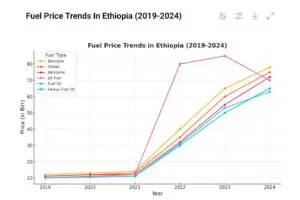Keeping the Pumps Running: Tackling Supply Chain Challenges in Ethiopia’s Fuel Market
Fuel is the lifeblood of any economy, powering everything from transportation and agriculture to industrial production. In Ethiopia, a nation undergoing rapid growth and development, the demand for fuel is rising steadily. Yet, ensuring a consistent and affordable fuel supply remains a formidable challenge. Supply chain issues, logistical bottlenecks, and geopolitical factors all play a role in disrupting the flow of fuel across the country.
In this blog post, we’ll take a deep dive into Ethiopia’s fuel supply chain, uncover the challenges it faces, and explore potential solutions to keep the pumps running smoothly.
1. Understanding Ethiopia’s Fuel Supply Chain
Ethiopia relies heavily on imported fuel to meet its domestic demand. With no major oil reserves or refineries of its own, the country sources petroleum products primarily from the Middle East and other international markets. These imports are brought into the country through the port of Djibouti, Ethiopia’s main access point to the global market.
From Djibouti, fuel is transported to Ethiopia via pipelines, road tankers, and railways, then stored in strategic depots managed by the Ethiopian Petroleum Supply Enterprise (EPSE). From there, private distributors supply fuel to gas stations across the country.
This multi-layered system is complex and vulnerable to disruptions, making Ethiopia’s fuel supply chain particularly challenging to manage.
2. Challenges in Ethiopia’s Fuel Supply Chain
Despite its growing fuel demand, Ethiopia faces several hurdles in maintaining a steady supply of petroleum products. These challenges include:
- A. Dependence on Imports
Ethiopia’s complete reliance on imported fuel exposes it to the volatility of global oil markets. Fluctuating prices, geopolitical tensions, and supply chain disruptions in oil-producing countries can quickly ripple through to Ethiopia, leading to shortages or price hikes.
- B. Limited Storage Capacity
Ethiopia’s storage infrastructure is inadequate to meet its growing fuel needs. Storage depots often operate at or near capacity, leaving little room to buffer against supply interruptions. This makes the country vulnerable to fuel shortages during periods of high demand or logistical delays.
- C. Logistical Bottlenecks
Transporting fuel from Djibouti to Ethiopia’s interior is a complex and expensive process. Road tankers and railways face frequent delays due to poor road conditions, customs clearance issues, and occasional strikes. These bottlenecks slow down distribution and increase transportation costs.
- D. Rising Demand and Limited Supply Points
With Ethiopia’s economy expanding, fuel demand is outpacing the development of new distribution points. Urban areas like Addis Ababa enjoy a relatively high concentration of gas stations, but rural areas remain underserved. This imbalance creates regional disparities in fuel availability.
- E. Fuel Subsidies and Smuggling
The government’s efforts to keep fuel prices affordable through subsidies have led to unintended consequences, such as fuel smuggling across borders. Subsidized fuel in Ethiopia is often illegally transported to neighboring countries, creating artificial shortages within the domestic market.
3. The Impact of Supply Chain Challenges
The consequences of an unreliable fuel supply are far-reaching. Transportation costs increase, affecting the price of goods and services across the economy. Farmers struggle to power irrigation pumps and transport their produce to market, while businesses face higher operational costs. These disruptions ultimately slow down economic growth and hinder Ethiopia’s development goals.
4. Solutions for a Resilient Fuel Supply Chain
Addressing Ethiopia’s fuel supply chain challenges requires a combination of infrastructure investment, policy reform, and innovative solutions. Here are some key steps that can help:
- A. Invest in Storage Infrastructure
Expanding fuel storage capacity is essential to buffer against supply disruptions. By building additional depots and upgrading existing facilities, Ethiopia can stockpile reserves to ensure a more stable fuel supply during periods of high demand or logistical delays.
- B. Strengthen Transport Networks
Improving transportation infrastructure—such as roads, railways, and pipelines—can significantly reduce bottlenecks in fuel distribution. The recently completed Addis Ababa-Djibouti railway is a step in the right direction, but further investments are needed to enhance connectivity across the country.
- C. Diversify Fuel Sources
Reducing dependence on a single port (Djibouti) or region for fuel imports can make Ethiopia’s supply chain more resilient. Exploring alternative entry points, such as Berbera in Somaliland, or diversifying suppliers can help mitigate risks associated with geopolitical tensions or market volatility.
- D. Curb Smuggling and Mismanagement
The government must strengthen measures to combat fuel smuggling and ensure that subsidies benefit Ethiopian consumers rather than fueling illegal trade. This could involve stricter border controls, better tracking of fuel distribution, and greater transparency in the subsidy system.
- E. Embrace Renewable Energy
As Ethiopia transitions towards a greener future, integrating renewable energy into the fuel supply chain could reduce reliance on imported petroleum products. Solar and hydropower solutions for rural gas stations or electric vehicle (EV) charging infrastructure could provide long-term sustainability.
- F. Leverage Technology for Efficiency
Digital tools can revolutionize Ethiopia’s fuel supply chain. GPS tracking, inventory management systems, and mobile apps can optimize fuel distribution, reduce losses, and improve service delivery. Technology-driven solutions like predictive analytics can also help forecast demand and prevent shortages.
5. The Role of Stakeholders
To build a more reliable fuel supply chain, collaboration between stakeholders is crucial:
- Government: Must invest in infrastructure, enforce anti-smuggling measures, and create policies that encourage private sector participation.
- Private Sector: Can contribute to expanding distribution networks, developing innovative solutions, and introducing renewable energy options.
- Communities: Should be engaged to identify local challenges and opportunities for improving fuel access.
6. The Road Ahead
Ethiopia’s fuel market holds immense potential, but addressing its supply chain challenges is critical to unlocking growth and prosperity. By investing in infrastructure, embracing technology, and fostering collaboration among stakeholders, Ethiopia can build a resilient fuel supply system that meets the needs of its growing economy.
With a well-functioning fuel supply chain, Ethiopia can ensure that businesses thrive, communities flourish, and the pumps keep running—fueling the nation’s journey towards a brighter future.
The road ahead is long, but with the right strategies in place, Ethiopia can transform its fuel supply chain into a backbone of sustainable development. It’s not just about keeping the pumps running—it’s about powering the dreams and aspirations of millions of Ethiopians.
Do you operate a gas station? You can use Gas Pro, the first gas station management software in Ethiopia, to get these benefits:
Automated Tank Monitoring
Using Gas Pro, you can automatically measure your tank at the press of a button. This saves you time while increasing your measurement accuracy
Real-Time Fuel Level Alerts
Gas Pro will give “low fuel alerts” when the fuel reaches critical level and “fuel tank full” alerts when they fill up. This enables gas station owners and managers to coordinate supply of fuel.
Theft and Loss Prevention
Gas Pro’s dual-level sensors detect theft or tampering, reducing financial losses. Accurate records of fuel deliveries prevent disputes with suppliers.
Remote Pricing Control
Gas Pro enables you to remotely adjust the prices on your gas pumps thus increasing your ability to react to price changes made by the government.
More Stories

Operational Inefficiencies in the Ethiopian Gas Station Industry
Manual dipstick measurements and inventory tracking are labor-intensive, error-prone, and time-consuming. These methods often result in inventory discrepancies, which can lead to financial losses and operational disruptions.

Keeping the Pumps Running: Tackling Supply Chain Challenges in Ethiopia’s Fuel Market
Fuel is the lifeblood of any economy, powering everything from transportation and agriculture to industrial production. In Ethiopia, a nation undergoing rapid growth and development, the demand for fuel is rising steadily. Yet, ensuring a consistent and affordable fuel supply remains a formidable challenge.

From Addis to Rural Ethiopia: Bridging the Fuel Access Gap
Bridging the fuel access gap between Addis Ababa and rural Ethiopia will require concerted efforts from all stakeholders, from government officials to private investors. With the right policies, infrastructure investment, and technological innovation, Ethiopia can ensure that all its citizens—regardless of where they live—have equal access to the fuel they

The Future of Fuel: Opportunities and Growth in Ethiopia’s Gas Station Market
Ethiopia’s gas station market is at the cusp of transformation, and for those looking to invest, the future offers plenty of opportunities to drive growth and innovation. Whether you’re an entrepreneur looking to build your brand or an investor seeking profitable ventures, this is a sector worth watching.

Rising Prices, Rising Challenges: Navigating Fuel Costs in Ethiopian Gas Stations
Fuel prices are a central concern for gas station owners, operators, and consumers across Ethiopia. As a country that imports the majority of its petroleum products, Ethiopia is highly sensitive to global oil price fluctuations, foreign exchange availability, and government-imposed pricing regulations.

Fueling Ethiopia: How Government Policies Shape the Gas Station Industry
The gas station business in Ethiopia plays a pivotal role in keeping the country’s economy moving. From fueling vehicles to powering machinery, the availability and pricing of fuel impact everything from transportation costs to consumer goods.
